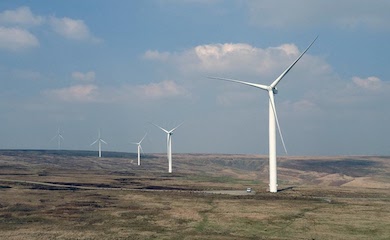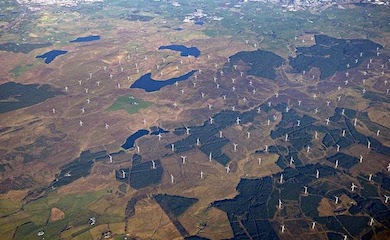Download the First Edition of our Telecommunications White Paper PDF here.
Over the last few months, many of the wind farm projects we have worked on have encountered complex telecommunications issues. This, coupled with the ongoing resurgence of onshore wind within the UK, has meant we thought it would be a good idea to provide a brief refresher course on the topic, looking at the key issues, the assessment process and mitigation. This article focuses on point-to-point communications infrastructure specifically.
What is Point-to-Point Communications Infrastructure
Point-to-point infrastructure is wireless directional communications links which send and receive data. They are typically used by utility companies, wireless broadband providers, mobile phone companies and emergency services – there are many different uses for the technology, which is not limited to the list above. It is common for the link ends to be located on tall masts and/or high ground to ensure visibility to other link ends. This, however, is often a prime location for wind turbines.
 Figure 1: Wind turbines. [1]
Figure 1: Wind turbines. [1]
Assessment Process
Firstly, consultation with the link operators must be completed to ensure the most up to date link data is assessed. Some of the stakeholders will provide data, some will keep the data confidential whilst providing advice, and some will request payment for their safeguarding services. Once link data has been received, the point-to-point link exclusion zones can be plotted as a constraints map if no turbine layout is available, or assessed against a specific wind turbine layout. Analysis can be completed in 2-Dimensions or 3-Dimensions (where ground heights, mast heights and turbine dimensions are considered). Ideally a wind farm should be located outside of the relevant exclusion zone for each communications link, but sometimes this is not possible due to other constraints.
Mitigation
Mitigation should be pursued as early as possible in the planning process to avoid any unnecessary objections. It is likely that any impact requiring mitigation can be managed through a planning condition. This will ensure there is no obligation to pay for mitigation prior to receiving planning permission. Technical mitigation is viable for communications links however the solution and the fee for mitigation varies on a case-by-case basis. The solution and fee will also be dependent on the number and type of communications links affected.
Conclusions
Consultation should be completed early in the planning process and the link exclusion zones should be calculated. These zones can be assessed against a specific wind turbine layout or plotted on a site boundary. The constraints should then be plotted against all other constraints to determine where it may be suitable to locate a wind turbine. If impact upon the point-to-point links cannot be avoided, then mitigation discussion should be pursued as a priority.
Additional Resources
Further information on communications issues surrounding wind farms can be found in the following articles:
- Communications planning issues for wind turbines
- What is a Fresnel zone
- Wind turbine terrestrial television interference
Click here to read the next article in this series, where we look at the different interference mechanisms and associated with wind turbines and other static structures.
About Pager Power
Pager Power undertakes technical assessments on behalf of developers, which include assessing whether a proposed development infringes instrument flight procedures and would cause a problem for said technology. For more information about what we do, Please get in touch.
References
[1] Sam Forson, March 30th 2017 on Pexels.com. Last accessed on 27th July 2022. Available at: https://www.pexels.com/photo/three-gray-wind-turbine-243138/



